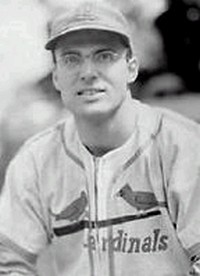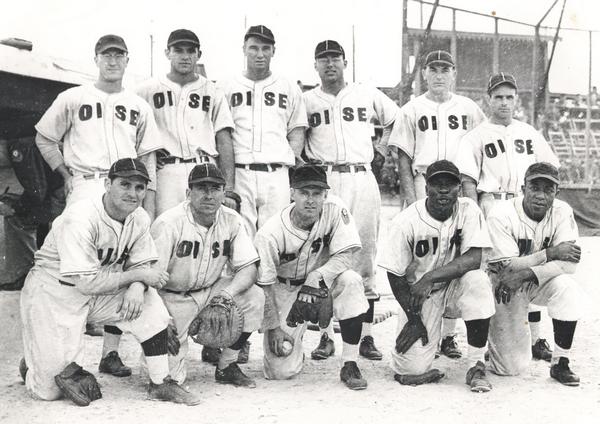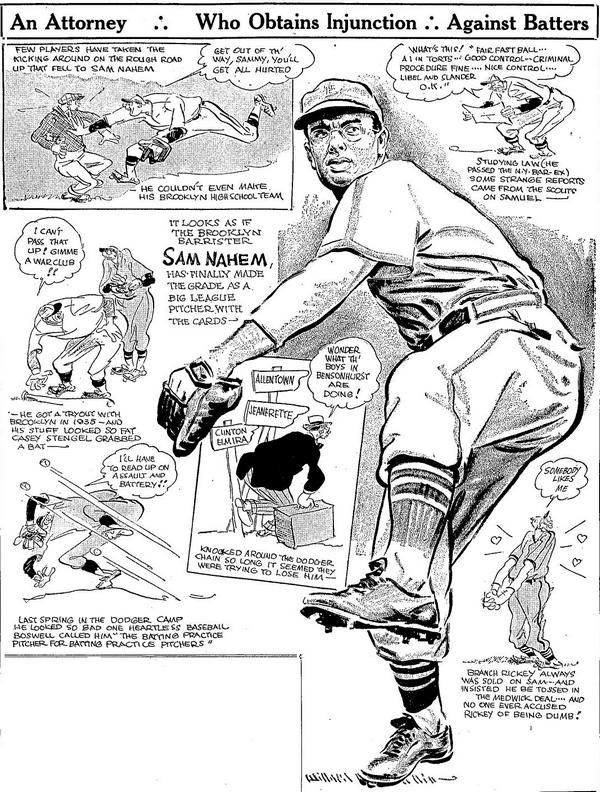

|
|
Sam Nahem
Date and Place of Birth: October 19, 1915 New York, New York
Died: April 19, 2004 Berkeley, California
Baseball Experience:
Major League
Position: Pitcher
Rank: Sergeant
Military Unit:
Area Served: European Theater of Operations
Nahem began playing baseball on the sandlots of Brooklyn because he
could not make the varsity team at New Utrecht High School. At the
time he was as a catcher but turned to pitching when he started
wearing glasses. “ I kept playing sandlot ball even when I couldn’t
make the team at New Utrecht High,” he told The Sporting News
on May 22, 1941, “and I guess I got better, or maybe it was just
that I got bigger. Anyway, I made the team when I went to Brooklyn
College.”
Sam played fullback on the Brooklyn College football team and, with
his brother Joe and Marius Russo, who later pitch for the Yankees,
made up the pitching staff. Sam Nahem beat Fordham with a 3-2
six-hitter in 1934, and beat St John’s with a 2-1, three-hitter the
following year.
Nahem was disappointed that the scouts didn’t come knocking so in
1935 he went to see Casey Stengel at Ebbets Field. “Casey must have
liked me,” he said, “because one morning when I was pitching batting
practice he grabbed a bat and got up there to hit against me. Maybe
it was because I looked easy to hit, I bore down hard, and Casey
didn’t get the ball out of the infield. So he promoted me – from
morning batting-practice pitcher to afternoon batting-practice
pitcher!”
The Dodgers sent Nahem to Allentown for the summer where he pitched
in relief. During the winter he went to St John's Law School and in
the spring the Dodgers assigned him to Jeanerette of the Evangeline
League.
Nahem was back at law school in the winter months and pitched for
Clinton in the Three-I League in 1937. Under manager Clyde Sukeforth
he was 15-5 and made the all-star team.
He pitched at Elmira in 1938 and then made his major league debut
with the Dodgers on the last day of the regular season, October 2.
Nahem pitched a complete game beating the Phillies 7-3 on just six
hits.
Nahem was at Nashville in 1939 and was on option to Louisville in
1940, when he was traded to the St Louis Cardinals on June 12. The
Cardinals sent Nahem to Houston in Texas League where he was 8-6
with a league-leading 1.65 ERA.
“In the playoffs,” Nahem explained, “I pitched two of the three
victories the Buffs needed to eliminate Oklahoma City; the first was
a four-hitter, and I didn’t let an Indian get to third. The other
was a six-hitter which clinched the series.”
Nahem joined the Cardinals in 1941. He was 5-2, primarily as a
relief pitcher with a 2.98 ERA. “Nahem is not a speed-ball pitcher
like these others,” catcher Gus Mancuso told The Sporting News
on May 22, 1941, “but he has a better all-round variety of stuff,
and fine control. He can pitch to spots, and he is smart. His slider
is real a humdinger.”
Nahem was purchased by the Phillies in February 1942, and made 35
appearances. He was 1-3 and had an ERA of 4.94.
He entered military service on November 25, 1942, and was stationed
at Fort Totten, New York, headquarters for the anti-aircraft section
of the Eastern Defense Command.
Corporal Nahem was still at Fort Totten in 1944, and on July 31, he
hurled the team to a 5 to 2, 10-inning victory over Bennett Field at
Brooklyn, New York. Nahem struck out eight. In August he defeated
the Department of Sanitation, 12-1, with a further eight strike
outs. On September 5, 1944, he single-handedly beat the Philadelphia
Athletics. He allowed just two runs and five hits over the six
innings he threw and hit two home runs.
Nahem was sent overseas in late 1944, and served with anti-aircraft
artillery. After the cease of hostilities in May 1945, Nahem,
promoted to sergeant, was running two baseball leagues for
servicemen in Rheims, France. He was also managing and pitching for
his own team – the OISE All-Stars, a team made up of mainly ex-minor
league players supplemented by Negro League stars Leon Day and
Willard Brown.
The OISE All-Stars proved a formidable team in France and went on to
represent Com-Z (Communications Zone) in the ETO World Series in
September 1945.
Despite the All-Stars standing in France, they were definite
underdogs going into the best-of-five World Series. Their opponents
– the 71st Division Red Circlers, who represented the
Third Army, had a lineup featuring outfielders
Harry Walker and
Johnny Wyrostek, infielders
Benny Zientara and
Bob Ramazzotti and a mound staff that included
Ewell Blackwell,
Al Brazle and
Ken Heintzelman.
The first game of the series was played at Soldier Field in
Nurnberg, Germany, on August 30, 1945. The Red Circlers took the
game, 9-2, with
Ewell Blackwell allowing just five hits.
Game two, also at Nurnberg, was a pitching duel with Negro League
superstar,
Leon Day, claiming a 2-1 victory for the All-Stars.
The third game of the series moved to the All-Stars home ground in
Rheims, France. Nahem took the mound for the home team and was
locked in a pitching duel with
Ewell Blackwell, winning 2-1 to give the All-Stars a 2 to 1 lead
in the series.
The Red Circlers came back to tie the series in the fourth game,
winning 5-0 against
Leon Day with a two-run home run from
Harry Walker. The fifth and deciding game was played at Nurnberg
on September 8, with Nahem and Blackwell again facing each other.
Nahem ran into trouble in the fourth inning and had to be relieved
but the OISE All-Stars hels on to win the game 2-1 and clinch the
ETO World Series crown.
When Nahem returned from military service at the beginning of 1946,
he was 30 years old and released by the Phillies. He began
practicing law in New York, while pitching for the semi-pro Brooklyn
Bushwicks at the weekend. In November 1946, the Bushwicks
represented the United States in the Inter-American Tournament held
in Caracas, Venezuela. Against teams representing Mexico, Venezuela
and Cuba, Nahem won three and lost one. He clinched the tournament
title for the Bushwicks with a 7-6 win over Cuba.
Nahem was again with the Bushwicks in 1947, and on October 12, he
pitched the Bushwicks to a 3-0 victory over the World Series
All-Stars before a capacity crowd at Dexter Park. Against a lineup
that included Eddie Stanky, Ralph Branca and
Phil Rizzuto, Nahem allowed just one hit, an infield roller by
Larry Miggins. It was his seventeenth win of the season.
In two seasons with the Bushwicks, Nahem was 33 and 6 with an
11-inning no-hitter. And on April 25, 1948 he hurled his last game
for the semi-pro team and returned to the Philadelphia Phillies. He
pitched 28 games for a 3-3 record and 7.02 ERA, receiving his
release from the club on September 20.
On October 17, 1948, Nahem appeared for the second time in a game
between the Brooklyn Bushwicks and the World Series All-Stars, but
this time he was on the All-Stars team along with Eddie Stanky,
Larry Doby and Tommy Holmes. The All-Stars were beaten by the
Bushwicks, 1-0, in a marathon extra-inning game, with Nahem going
the distance and yielding the unearned winning run in the bottom of
the 14th.
Nahem was back with the Bushwicks in 1949 with a 10-7 record, and
married art student, Elsie Hanson. They had three children, and
moved to the East Bay in 1955 and to Berkeley in 1964.
He
worked for Chevron Chemical in Richmond, where he became a head
operator, and stayed there 25 years. He was also a leader of the
Oil, Chemical and Atomic Workers of America.
In his latter
years, Nahem volunteered at the University Art Museum in Berkeley.
Sam Nahem passed away at his home in Berkeley, California on
April 19, 2004. He was 88 years old.
Thanks to the late Sam Nahem and his son, Ivan, for help with this
biography.
Created June 11, 2007.
Copyright © 2007 Gary Bedingfield (Baseball
in Wartime). All Rights Reserved. 


OISE
All-Stars 1945 ETO World Series Champions (Nahem is back
row, first left)
